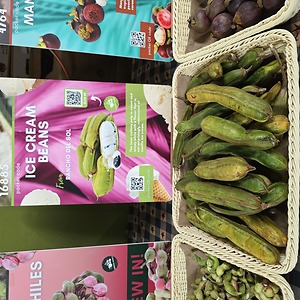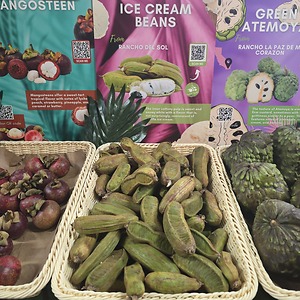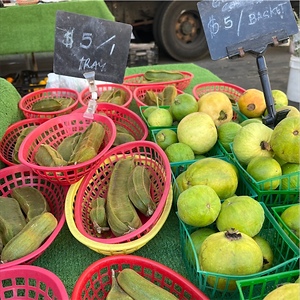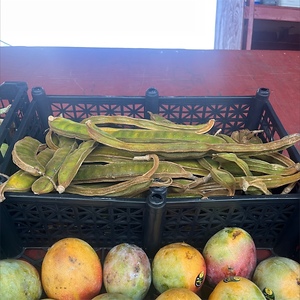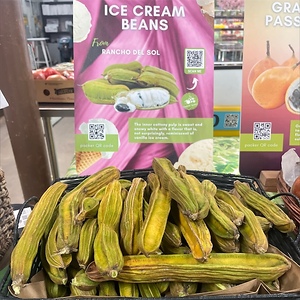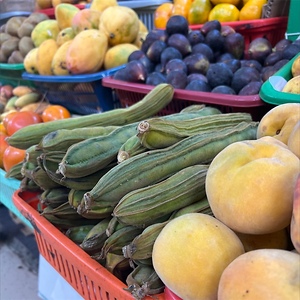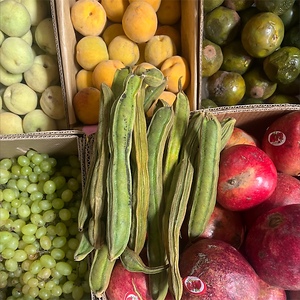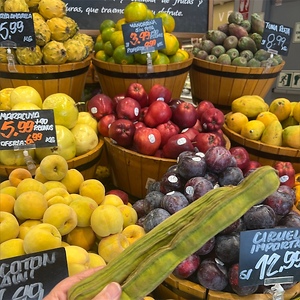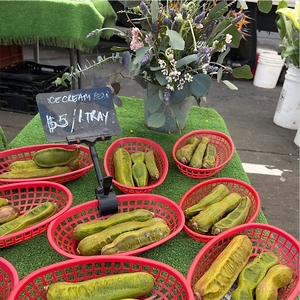


Ice Cream Beans
Estimated Inventory, lb : 0
Description/Taste
Ice Cream beans widely vary in size, ranging from 50 to 100 centimeters in length, and have a cylindrical shape with curved, blunt ends, displaying several raised and longitudinal ridges extending the length of the pod. The pods hang from the tree, growing in straight, twisted, to spiraled formations, and the longest Ice Cream bean pod ever recorded reached to 2.07 meters in length. The pods have a textured, leathery, and ridged feel and are semi-thick but easy to break open with fingers. The pod’s surface also appears in hues of dark to bright green, transforming into a yellow-brown shade when the flesh is ripe. Once the pod is opened, several small sections of translucent-white flesh surround 10 to 20 seeds. The pulpy flesh is edible, airy, delicate, and cotton-like, reminiscent of the texture of cotton candy with a lightly moist, spongy, and chewier mouthfeel. The seeds are glossy, firm, hard, and smooth, appearing in dark purple, almost black hues. When the seeds are split open, they reveal a bright yellow-green interior. Ice Cream beans are generally consumed when the pods have turned into shades of yellow-brown, but the exact coloring and time will be different with each type of Ice Cream bean. The flesh is the main portion of the pod consumed, and the light and airy pulp has a sugary-sweet, delicate flavor with hints of cream, vanilla, and cinnamon. The seeds can also be consumed when cooked, developing a mild and nutty flavor, but they should never be eaten raw and are considered toxic. It is important to note that the pods are not edible and should be discarded.
Seasons/Availability
Ice Cream beans are available year-round.
Current Facts
Ice Cream beans, botanically classified as Inga edulis, are unusual pods that grow from large, wide-spreading trees belonging to the Fabaceae family. Ice Cream bean trees are native to South America and can reach anywhere from 17 to 30 meters in height. There are over 350 species found within the Inga genus that are similar in appearance, growing leathery pods with sweet flesh. These pods are considered a type of legume, and due to their similarities, many species are often mistaken for one another. The pods are also generally labeled with encompassing regional names in markets to simplify the point of purchase. Ice Cream beans are known as Pacay in Peru, Guama in Colombia and Puerto Rico, Guaba in Ecuador, Jinicuil or Baina in Mexico, Padoo in the Caribbean, Cushin or Paternas in Guatemala, Poix Deux in Trinidad, Buah Salji in Indonesia meaning "Snow Fruit," and Inga bean, Inga cipo, Pois Sucre, Rabo de Mico, and Monkey Tail. The pods were later given their ice cream moniker for their similarity in flavor and smooth texture to vanilla ice cream. Despite their unusual pods, Ice Cream bean trees have historically been planted for use as shade trees. The large, canopied trees are fast-growing and provide ample shade for coffee and cacao plantations. The roots of the trees also add nitrogen to the soil, making the ground more fertile for crop cultivation. Beyond plantations, Ice Cream bean trees are also valued as an ornamental addition to home gardens, neighborhood parks, and city squares. The trees are considered visually attractive with wide-spreading branches and elongated, hanging pods and are often planted by themselves to showcase their unique appearance. Ice Cream beans are localized to their growing environments and cannot be exported long distances due to their perishable nature. The pods can be found through local markets and are typically consumed fresh, out of hand, to savor the flesh’s spongy, sweet consistency.
Nutritional Value
Ice Cream beans are a source of calcium and phosphorous to build strong bones and teeth, fiber to regulate the digestive tract, and vitamin C to strengthen the immune system while reducing inflammation. The legumes also provide antioxidants to protect the cells against the stress caused by free radicals. In traditional South American medicines, Ice Cream beans are believed to help stimulate digestion, relieve stomach irritations, and act as an anti-inflammatory. When cooked, Ice Cream bean seeds contain some protein.
Applications
Ice Cream beans have a delicate, sweet, and airy flavor well suited for fresh applications. The pulp’s cotton candy-like consistency is showcased when consumed straight, out-of-hand, and the pods can be broken open using fingers. Once opened, the pulp can be gently peeled from the seeds and eaten raw. It is recommended to try sucking or chewing the flesh to experience its light but juicy mouthfeel. Ice Cream bean pulp can be incorporated into salads, infused into syrups, or used as a unique element in smoothies, juices, and cocktails. It can also be combined with avocado and sugar to make vegan ice cream or incorporated into desserts such as mousse, chocolate, and candy. Ice Cream bean pulp is not commonly cooked as its textural integrity cannot stand up to extensive heat. Unlike the delicate flesh, the seeds are inedible when raw, but they can be boiled in salted water and consumed as a snack. They can also be roasted or baked, ground into a powder, and scrambled into eggs, coffee, or used as flour. Ice Cream beans pair well with fruits such as bananas, pears, apples, mangos, strawberries, and coconut, spices including cinnamon, allspice, cloves, ginger, and cardamom, vanilla, chocolate, caramel, cream, and nuts such as almonds. Whole, unopened Ice Cream bean pods have a short shelf life and only keep for 3 to 5 days at room temperature and 1 to 3 weeks when stored in a plastic bag in the refrigerator. Once opened, the flesh should be immediately consumed for the best quality and flavor.
Ethnic/Cultural Info
Ice Cream beans are traditionally consumed fresh as a sweet treat or snack to quench thirst throughout South America, but in Colombia, a rare, alcoholic beverage known as cachiri is made from the arils. Cachiri is named in honor of its localized region of Cachiri, located in the department of Santander in Northern Colombia, and the drink has been made among indigenous peoples for centuries. Cachiri is made from chewing the roasted arils of the pod and spitting the mixture into a container with water to ferment. Mixing saliva with the arils introduces natural enzymes that help transform carbohydrates into monosaccharides, aiding in the fermentation process. After the mixture is left for several days, it is consumed in filtered or unfiltered variations. Cachiri is a specialty drink typically served throughout festivals held in the Cachiri region.
Geography/History
Ice Cream beans are native to South America, where the legume has been growing wild since ancient times. Evidence of the tree’s use is depicted on Incan pottery, and seed remnants were found in tombs dating back to 1000 BCE. In South America, experts believe Ice Cream beans may have originated in tropical regions, specifically the Amazon rainforest, and thrive alongside rivers, swamps, flood plains, and forest edges. Over time, Ice Cream bean seeds were carried to coastal regions of South America and were spread into Central America and Mexico, planted as an ornamental and food source. Today Ice Cream beans grow wild from Mexico to South America and have been naturalized in tropical to subtropical climates worldwide. The legumes are not exported due to their short shelf life and are localized to their growing regions, sold fresh in markets, or foraged from wild trees. Outside of Central and South America, Ice Cream beans are cultivated through select growers and home gardeners in the United States, especially in Southern California, Hawaii, and Florida, the Caribbean, Australia, and Southeast Asia.



